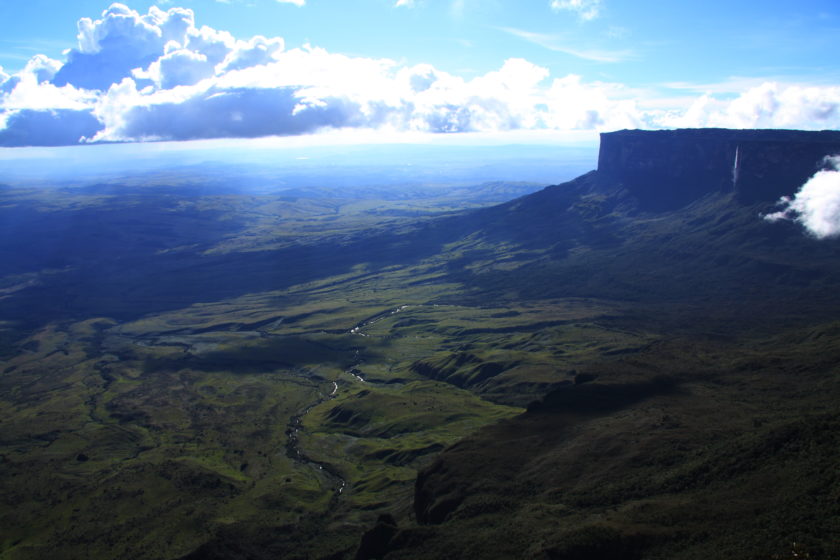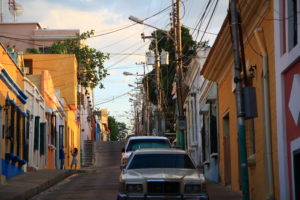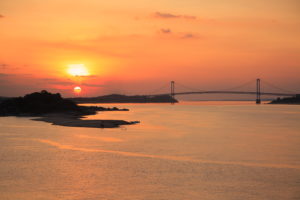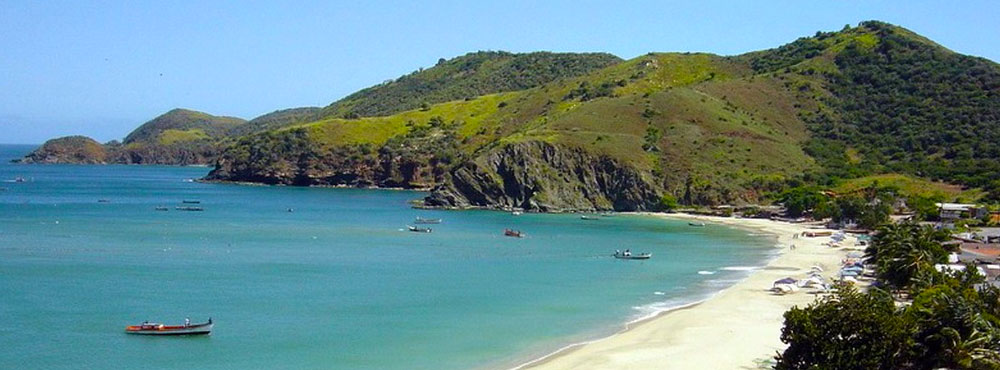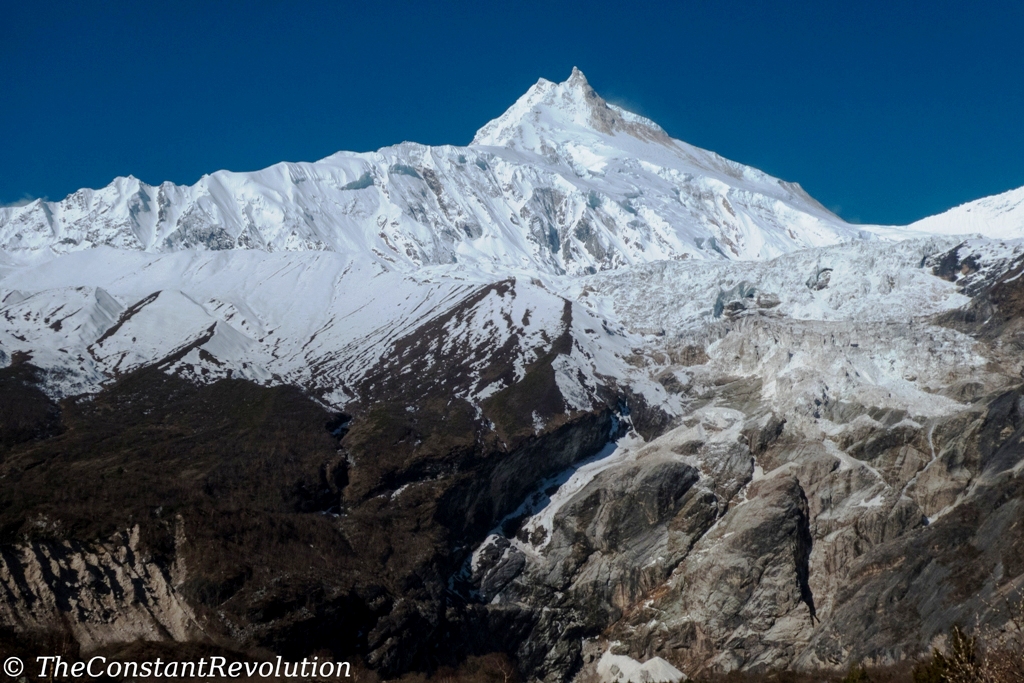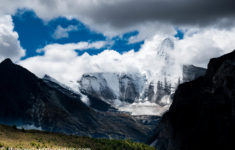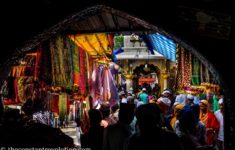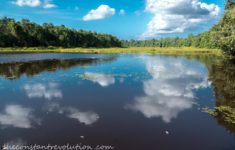Venezuela has been my first international travel experience, and what an experience! Since then I have visited, and trekked, some amazing places around the world, some of them quite remote like in New Zealand, or Chilean Patagonia, or Iceland, but none was just like this one. Mount Roraima is a special, unforgettable place, for many different reasons.

For example, for both its eco-system and its geology, which are unique in the world. Not by chance, Sir Arthur Conan Doyle got inspired by this view to write the novel “The Lost World”. To me, living in the time of cinematography, the landscape reminded of Jurassic Park.
An ancient, top flat mountain, with steep cliffs of naked rock hundreds of meters high, jungle-like vegetation in the middle, and surrounded by a vast savanna. Many are the waterfalls falling down on its side. Roraima in the local Pemon language means mother of all waters.
Just getting to the beginning of the trek was an adventure: after arriving in Caracas with an international flight, we had to catch a medium-sized internal flight to Ciudad Bolivar, halfway through to our destination. From there, we organised a chestnut flight to go over mostly jungle area. We were in 4, so just enough to fit in (one extra place was possible in the tail of the plane). That was the first, and only such experience in my life: being on the side of the pilot, talking to him, kidding around, targeting clouds, feeling every push of the wind, and looking at the amazing view below us was all really emotional.
On the plane itself, nothing seemed to work but for one instrument. We were reassured by the pilot that as long as that instrument worked, we had nothing to worry about. Then, he said, if something happened such a light plane could just gently glide down. Sure, only down there was the jungle for hundreds of Km, with trees over 50 m. high. Not an easy glide, nor landing, I figured.
The chestnut flight was fun. Also, lucky us, during our return trip we took a detour to leave an extra passenger in another place, and because of that, we passed right in front of Salto Angel, the highest waterfall in the world, another of many Venezuela’s treasures. A welcome unforeseen circumstance.

THE TREK
Anyways, from Ciudad Bolivar, we arrived in a town called Santa Elena de Uairén, where a three hours car drive took us to a small Pemon village. There, the trek could finally begin. We could already see, far in the distance, the flat top shape of mount Roraima and mount Kukenán, a solitary pair in the middle of La Gran Sabana (The Great Savanna), inside Parque Nacional Canaima.
Roraima is the tallest of the two, about 2,800 m. above sea level. It stands right on the border with Brazil and Guyana. In fact, the border of the three countries meets in one spot, called tripoint, at the top of Roraima. Not easy to find though, as the whole area covers more than 30 square Km.
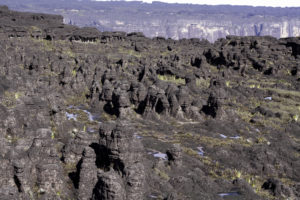
So, we familiarized with our guides, people from the villages in the area, and set out for our trail. The trek lasted 6 days and 5 nights. I am not going to pinpoint where all the camping sites were, they are quite compulsory steps anyway. Until the mountain feet, the route is quite easy to follow. The way up as well, more or less. But I would recommend to always go with a local guide, especially for strolling around at the top of the mountain, a very wide area with no signals. Getting lost up there is a serious possibility. Guides can be hired by booking a tour through an agency, or directly on site for a cheaper fee.
These guys know everything about the national park, where to find shelter, where to enter caves, where are the best viewpoints, information about its unique eco-system with many carnivorous plants and tiny black frogs. Plus they can tell you about their own culture as well, they told us stories overnight around a fire, and sang songs… it isn’t just about not getting lost, it’s actually a nice experience to have them around.
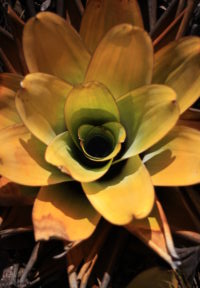
The first three days are needed to hike to the top. Day one and two are basically long walks, ups and downs on the hilly savanna. The most impressive part of this was the silence. There are no animals and, at least at the time, very few tourists. In fact, we were on our own most of the time, we met another group or two only, and not at the campsites. I still have this vivid memory of my steps being the only sound I could hear while watching this majestic space around me. So I stopped walking for a moment, and the silence was absolute and beautiful!
On day three we hiked to the top, about 1000 metres in level difference. It is neither a hard nor an easy climb, but there are slippery passages through the vegetation, passages under the waterfalls where you can get soaked if not adequately equipped, and the weather changes real quick too. We made it just in time to our shelter at the top (a big roof-like rock that our guides called the hotel) to avoid a torrential rain that lasted several hours through our third night.
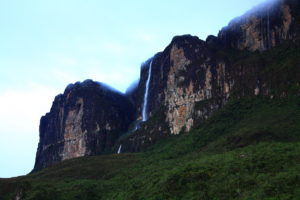
On the morning of the fourth day, we were rewarded though: one of the best dawns I have ever seen! Couldn’t take a picture, I just enjoyed the moment. We spent the day visiting a little part of Roraima’s roof, with a couple of fantastic viewpoints and some caves and slept in the same spot. Then, we spent the next couple of days going back to where we came from the same route.
SOME PRACTICALITIES
All in all, the Roraima trek remains one of the most remote places I have visited, and the most unique for sure. Equipment is no different than what is needed for any other multi-day trek. In February, it rained for a couple of days, in the night was humid and chilly, during the day quite hot, and there were a lot of mosquitoes. I even got stupid second degrees burns on my legs because I forgot the solar protection on a cloudy afternoon, and I had to hike for the remaining 5 days with long pants and a lot of pain. Guides are essential, they can help with porters for food and tents as well if needed. Otherwise, it’s just a magnificent experience. And remember, the silence!
TOURISM IN VENEZUELA
This trip took place in 2010. I realize that as I write (2017) Venezuela might be a somewhat more difficult country to visit. The political situation is not easy, the economy not doing so well either, criminality is quite high. Some people still go, but I think lots of attention is needed. Even back then we avoided Caracas, and when walking overnight in cities we were very careful. Well, not enough apparently as the only night we spent in Ciudad Bolivar (which was also the only night we spent in a city now that I think about it) we were naively stepping into the wrong streets, if it wasn’t for some nice ladies sitting outside their houses who told us (with their fingers) not to go there. Ouf! In the end, we didn’t have one single problem in terms of security, so that’s that. At the same time, we spent more time in a tent, and on an island after the trek, so that’s that too.
I am just going to add a couple of photos of Ciudad Bolivar here because I like them, one is just a shot of the town, and the second one a nice sunset on the Orinoco 🙂

Viva the transparency! There are affiliate links in this article. This means if you click on a link and end up buying (or booking) through those websites, I’ll get a small commission, at no extra cost to you. This helps me maintain the blog, and continue to provide (hopefully) useful travel information. I advertise only products I have tested and sites I use myself!
